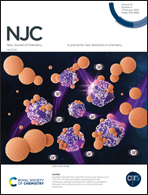Molten salt-mediated synthesis of porous N-doped carbon as an efficient ORR electrocatalyst for zinc–air batteries†
Abstract
N-doped carbon materials are considered as one of the most promising alternatives for oxygen reduction reaction (ORR). However, they are usually limited due to their low porosity and low active N content. Here, we use adenine as a nitrogen-doped carbon (NC) precursor and the NaCl and ZnCl2 mixed molten salt as a template, and show that the pore structure of carbon materials can be controlled by adjusting the pyrolysis temperature, facilitating the exposure of active sites and improving the graphite-N content. Experiments showed that SZ-NC-900 (where S represents sodium chloride, Z represents zinc chloride) had a hierarchical porous structure (specific surface area was 2710.58 m2 g−1) and high N-doping content (8.93%). Therefore, it exhibited comparable ORR activity in alkaline medium (half wave potential was 0.856 V versus reversible hydrogen electrode). After 5000 cycles, the half-wave potential of SZ-NC-900 shifted only 1.4 mV compared with Pt/C (53 mV). In addition, the zinc–air battery (ZAB) prepared with SZ-NC-900 as the catalyst was superior to the Pt/C-based ZAB, further proving its application value.



 Please wait while we load your content...
Please wait while we load your content...